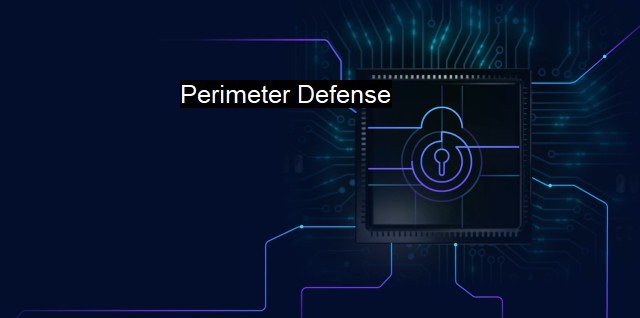What is Perimeter Defense?
point in protecting against cyber threats: The importance of perimeter defense in cybersecurity
Perimeter defense is a key concept particularly common within the discourse related to antivirus protection strategies. this term picks up derivatively from its traditional use in military parlance where it was used to refer to the boundary of a physically secured space. the perimeter defense refers to measures designed to protect the electronic frontier of a network from external threats or unauthorized intrusion attempts.Traditionally, this perimeter was considered to be the edge of a network that is directly accessible from the internet. Typical elements of a conventional perimeter defense strategy included things like firewalls, intrusion detection systems (IDS), and intrusion prevention systems (IPS). These are essentially tools facilitating identification and prevention of unauthorized attempts seeking entry into the network. by analyzing traffic moving in and out of the network periphery to detect abnormal patterns or known threats.
Antivirus software, for all its critical importance, isn’t sufficient by itself to guarantee network security. A broader approach is needed in order to guard against the range of threat vectors. This is where the holistic concept of perimeter defense comes in. A multilayer approach is typically used with varying layers or tiers of credible soft blocks planning to deny access or early tripwire systems designed to detect possibly malicious activity with low performance overhead and high tolerances for false positives.
In today’s digital landscape, with the rising trend towards decentralized network architectures, the perimeter-based defense concept has become a lot more complex. This is mainly due to the blurring of network boundaries caused by increased cloud reliance, use of mobile devices, and distributed workforces. With the adoption of distributed servers and application-driven platforms, conventional perimeters have dissolved which increased the potential attack surface.
Truth be told, across numerous small, medium, and even above-scale business establishments, the classic notion of perimeter defense known by experts in this field is moving towards a rapid extinction. Instead, this is being substituted by credo such as zero-trust framework, symbolizing an ingrained doubt impressed upon all access requests with validation undertaken every single time, before granting permission. This is irrespective of whether the request has come in from within or outside of the original organizational periphery. This keeps potential cyber threats at bay, reducing the surface damage area as much as possible.
It is absolutely critical to be cognizant of dynamic cyber threats and cultivate multi-tiered, adaptively evolving cyber defense mechanisms. Massive sets of data, intricately intertwined, are becoming transmission hubs, exchanging quantum packets of information across electronic highways. A simple loophole or an open chink in this closely-knit technological armor can provide cybercriminals with a covert entry passage, a fact terrorizing IT industry and firms likewise.
While perimeter defense officialdom may have had a distinctive version shift, it is by no means any less significant today. While yesterday's approach inferred ring-fencing the organizational electronic radius with a single line of protection, modern implementation places less emphasis on denial of ingress and instead, intensifies dynamic proxy threat models and employs the recurrent validation principle, meticulously ascertaining credentials to eliminate the risk extensively associated with cybercrime.
Thus, diligently observed, digitized defense proximities authenticate authorized entries while keeping consummate efficacy. Strategically, it serves as the first line of a detailed, multiple-staged action plan which when placed aptly, paves the way for secure operational helicals. Perimeter defense continues to evolve, embracing new approaches and technologies even as it holds on to the essence of its traditional methods to ensure the vitality of network security.

Perimeter Defense FAQs
What does perimeter defense mean in cybersecurity?
Perimeter defense in cybersecurity refers to the practice of securing the external surface of a network with firewalls, intrusion prevention systems, and other security measures. The goal is to protect against unauthorized access, data breaches, and other cyber attacks.What are the benefits of perimeter defense in cybersecurity?
The benefits of perimeter defense in cybersecurity include protecting sensitive data, reducing the risk of cyber attacks, and minimizing the impact of any successful attacks. Additionally, perimeter defense helps maintain compliance with industry regulations and standards.What are some common techniques used in perimeter defense?
Common techniques used in perimeter defense include firewalls, intrusion detection and prevention systems, antivirus and anti-malware software, access controls, and security information and event management (SIEM) systems. These tools work together to create layers of protection against potential threats.Why is perimeter defense important even with antivirus software?
Perimeter defense is important even with antivirus software because antivirus software alone cannot detect every type of cyber threat. Perimeter defense helps to prevent malware from entering the network in the first place, making it less likely that antivirus software will need to detect and remove threats. Additionally, some cyber attacks, such as denial-of-service attacks, can overwhelm a network even if antivirus software is in place, making perimeter defense critical for defending against these types of attacks.| | A | | | B | | | C | | | D | | | E | | | F | | | G | | | H | | | I | | | J | | | K | | | L | | | M | |
| | N | | | O | | | P | | | Q | | | R | | | S | | | T | | | U | | | V | | | W | | | X | | | Y | | | Z | |
| | 1 | | | 2 | | | 3 | | | 4 | | | 7 | | | 8 | | |||||||